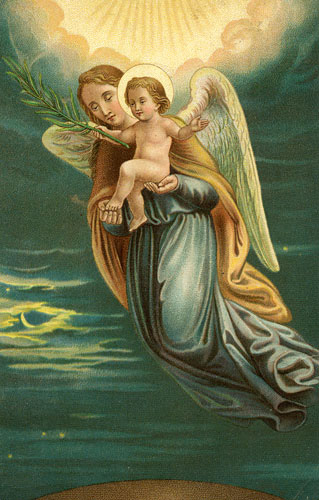Angel, is a word signifying messengers, both in Hebrew and Greek, and therefore used to denote whatever God employs to execute his purposes, or to manifest his presence or his power. In some passages it occurs in the sense of an ordinary messenger (Job i:14; I Sam. xi:3; Luke Vii:4; iX:52); in others it is applied to prophets (Is. lxiii:i9; Bag. i:13; Mal. iii); to priests (Eccl. v:5: Mal. ii:7); to ministers of the New Testament (Rev. i:20). It is also applied to personal agents; as to the pillar of cloud (Exod. xiv:19; xiii:21;xxxii:34); to the pestilence (2 Sam. xxiv:16, 17;2 Kings xix:30); to the winds (‘who maketh the winds his angels’ Ps. civ:4); so, likewise, plagues generally are called ‘evil angels’ (Ps. lxxviii:49), and Paul calls his thorn in the flesh an ‘angel of Satan’ (2 Cor. xii:7; Gal. iv:13, 14). . . . → Read More: Angels in the Bible: Part 1
|
|
|||
|
Triumph of the Innocents by Holman Hunt [Part 1] [Part 2] [Part 3] In this front rank of great religious artists we must also place Mr. Holman Hunt, whose work has appealed so strongly to the popular mind, without any deliberate attempt on his part, however, to make it do so. His great picture, “The Triumph of the Innocents,” demands mention here for the beauty of the angelic children who, seen alone by the infant Christ, are accompanying the Holy Family to Egypt. The picture was at the Guildhall Exhibition a year or two ago, and is now in the Walker Art Gallery, Liverpool. . . . → Read More: Angel Art: Part 4 At the close of the previous article [Angel Art – Part 2] I ventured to express the opinion that we should find the most successful modern artists who have pictured the angelic form to be those who have worked in the same simple spiritual manner as did the Pre-Raphaelite Italian painters. The religious ideal in art has been seldom attained: it demands something more than mere technical skill: the quietude of life, the purity of thought, the calm faith which Fra Angelico cultivated, are needed to produce the proper state of mind to direct the physical power of the work. There have been many modern painters who have set themselves to paint religious pictures, but those to whom success can be attributed are few. . . . → Read More: Angel Art: Part 3 Bearing these remarks in mind, [Angel Art: Part 1] let us examine the pictorial representations of angels by the early masters in art. It is necessary, too, to remember that Christian art at the first was directed and controlled by the Church. Art was bound to the service of religion: all its life and force were expended upon it, and, indeed, the workers themselves were, for the most part, until the thirteenth century, of the Church. We cannot touch upon the crude productions of the very early artists, and can only barely refer to the culmination of their art as exhibited in illuminated manuscripts. The beauty and delicacy of these decorated parchments are wonderful. With the use of the primary colours and gold, these, to us nameless, workers produced miniature pictures the charm of which—more than six centuries after their creators have passed away—still enthralls us. . . . → Read More: Angel Art: Part 2 |
|||
|
Copyright © 2024 Christian Image Source - All Rights Reserved |
|||
 Angel Graphics
Angel Graphics


Angels in the Bible: Part 2
[Part 1] (6) In Human Form In the Scriptures angels appear with bodies, and in the human form, and no intimation is anywhere given that these bodies are not real, or that they are only assumed for the time and then laid aside. It was manifest indeed to the ancients that the matter of these bodies was not like that of their own, inasmuch as angels could make themselves visible and vanish again from their sight. But this experience would suggest no doubt of the reality of their bodies; it would only intimate that they were not composed of gross matter. . . . → Read More: Angels in the Bible: Part 2